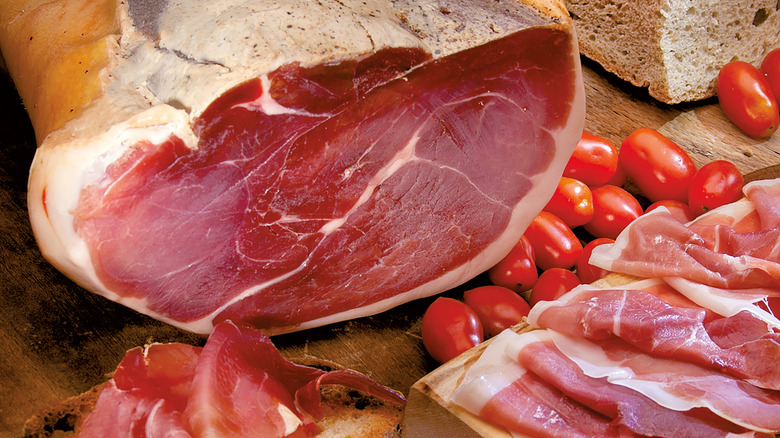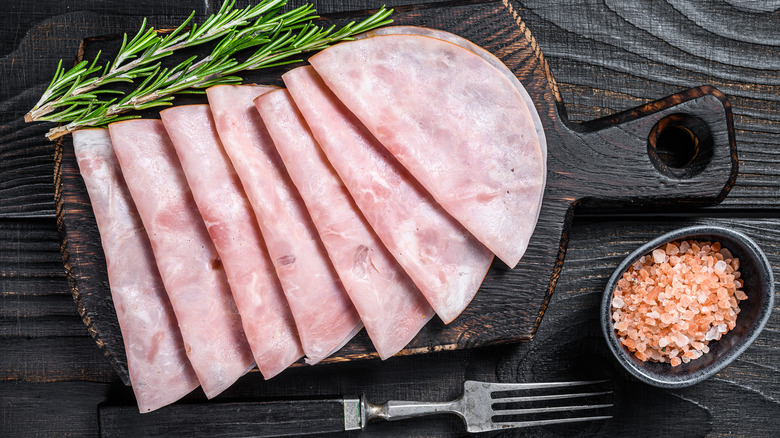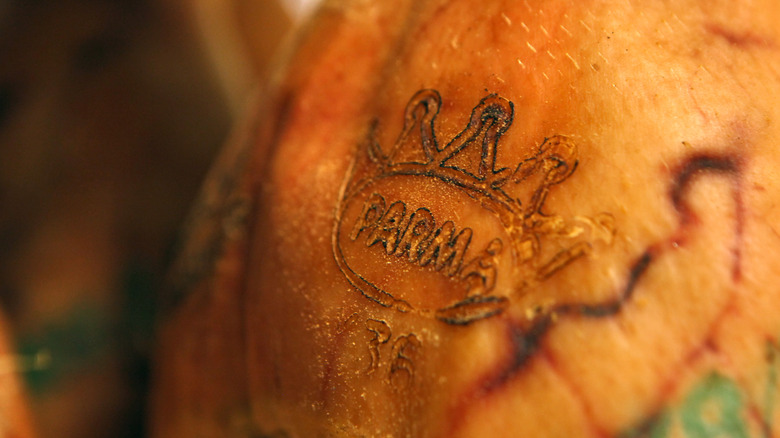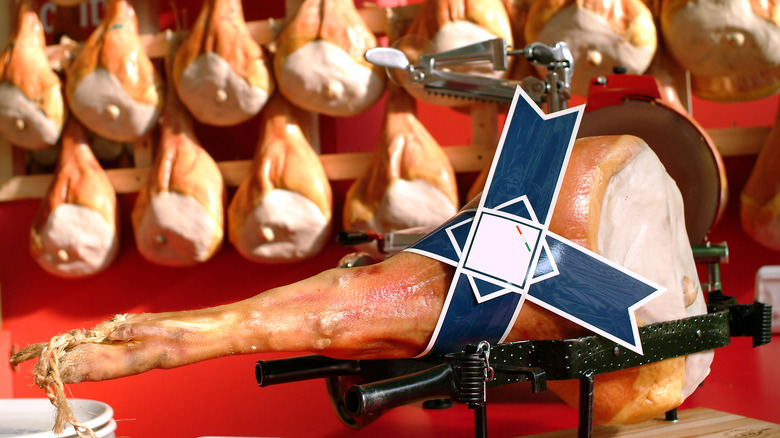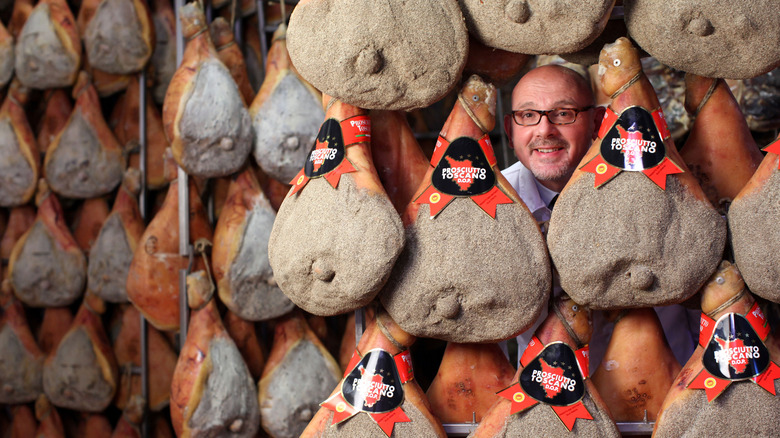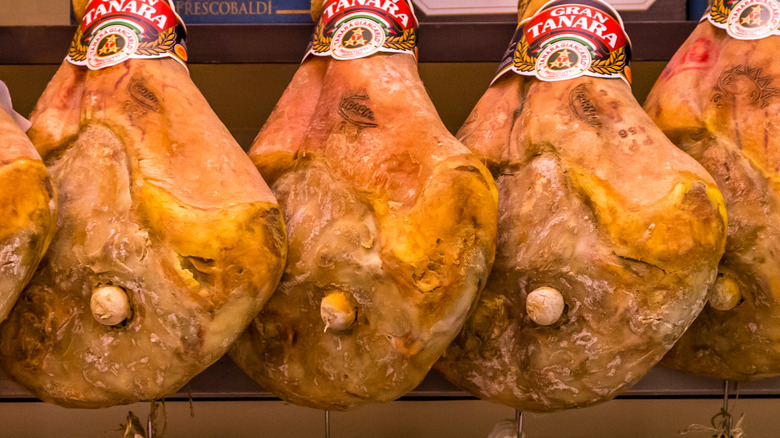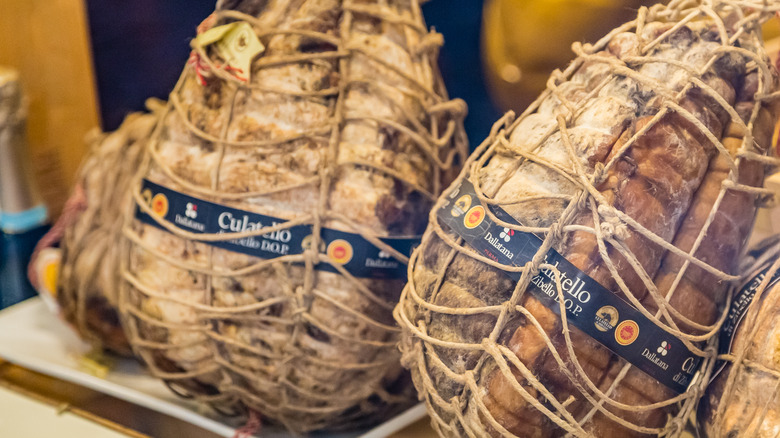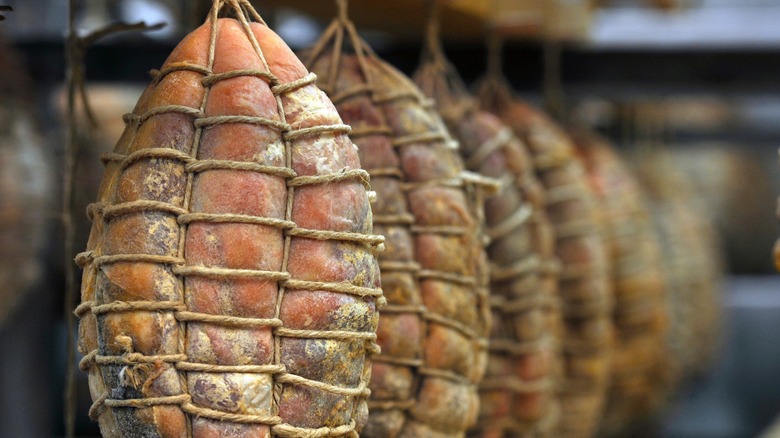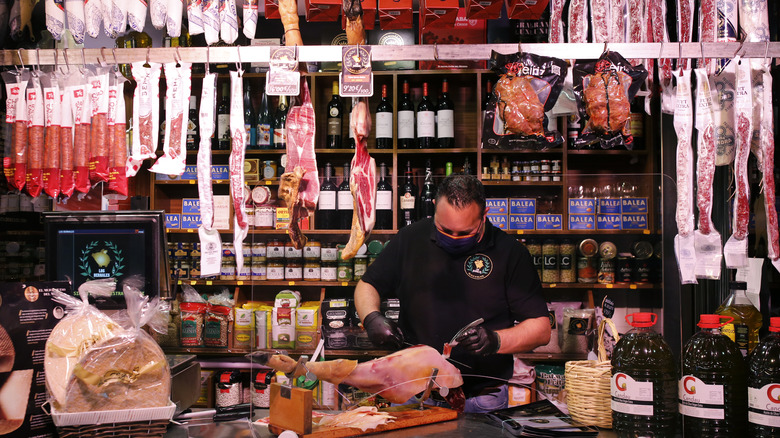9 Types Of Prosciutto Explained
Cured or cooked ham is made in many regions around the world. In fact, the technique behind curing food dates back to ancient times. According to Food Processing History, Mesopotamians began using salt to cure and dehydrate fish and meat as early as 3000 B.C., with the Greeks adopting the practice around 900 B.C. Seven hundred years later, Romans began using salt to cure pork — an early precursor to today's prosciutto. As the Roman empire expanded across Europe, soldiers and settlers populated regions in Portugal, Spain, France, England, Germany, and Belgium (via Britannica). These pioneers took their gastronomic culture with them, including salt-curing techniques. Salt curing delays spoilage and desiccates meat — and when food was scarce, this technique became a staple for people living in these outposts (via National Center for Home Food Preservation).
Taste Atlas indicates that there are 132 types of cured meats from across the globe. Spain, Portugal, France, Germany, and the U.S. all produce popular, high-quality cured ham. Each variety is distinguished by the geography, climate, and vegetation of the country it hails from just as much as it is by the type of pig used. The highest quality cured ham attributes its flavors and textures to specific heritage hog breeds, processing and curing techniques, and aging durations.
Italian prosciutto is one of the most famous types of cured ham. It is identified by its paper-thin slices, sweet-salty flavors, and delicate fat marbling. However, not all Italian prosciutti are the same. Prosciutto expert, Sabina Besler of Musco Foods, shared her insights on the various styles of prosciutti with us.
Cotto ham
Fine Cooking notes that prosciutto cotto is an Italian ham that is slow-cooked with its skin on before maturing. According to La Cucina Italiana, cotto ham is brined and steamed at a low temperature for a few days whereas crudo is cured and aged raw (no steaming or cooking). As with Italy's finest crudo prosciutti, heritage hogs are selected for their finest qualities. Once butchered, the legs are deboned, fat is trimmed, and hams are shaped.
Natureword reveals that some cotto are flavored with aromatic herbs and spices such as bay leaf, juniper, pepper, and even precious truffles, before being brined and aged. Most of the fat marbling dissolves during the cooking process, leaving a lean and flavorful ham that is lower in sodium than its salt-cured sibling. Similar to deli-style ham, cotto is still thinly sliced but may not be paper thin like crudo.
So, is crudo healthier than cotto? Sabina Besler states that "healthy is a complicated term. Prosciutto crudo contains no added nitrates or nitrites. While it does have a high salt content, it is meant to be enjoyed in small quantities and eaten slowly with friends and a good glass of wine. The Italian prosciutto cotto that is imported in the United States tends to be of a much higher quality than what you will find behind the typical deli counter. They are made of one whole piece of meat, slowly steamed. Domestic hams are often made of lots of different cuts compressed together and 'glued' with various additives."
Prosciutto di Parma
"Italian prosciutto — and I can speak about di Parma and San Daniele especially — is a product born of the overlap of culinary expertise and the land," says Besler. "You will hear a lot about how the land allows them to create the best prosciutto. The location of the Emilia Romagna region (in North-Central Italy), tucked in between the Apennine mountains and the Adriatic sea, is key."
Prosciutto di Parma DOP (Protected Designation of Origin) is crafted under the governance of the Consorzio del Prosciutto di Parma with the strictest regulations. The Consorzio stipulates that only heritage hogs from the Parma and Langhirano regions are allowed to be used for prosciutto. Parmigiano-reggiano also comes from Emilia Romagna. The salty cheese is perfect with prosciutto crudo. In fact, hogs destined to become prosciutto are reared on Parmigiano-Reggiano whey to add flavor, fat, and texture, to the sweet, nutty, savory cured meat. After hanging in aging rooms for extended periods of time, each prosciutto di Parma leg or parcel is stamped with the Ducal Crown symbol and the Parma name to indicate its place of origin.
Besler stresses that "prosciutto dries for a long time, and it is key to keep the air moving in the curing rooms to avoid the proliferation of bad bacteria and dry out the meat evenly. The geographic placement of Emilia Romagna allows for it to be swept by refreshing breezes — perfect for curing rooms! Traditional curing rooms have tall windows that allow all that fresh air in."
Prosciutto di San Daniele
"Di Parma is the one with the largest production and the biggest exports — it's cured with only salt and air. Let's use it as the 'baseline,' as it's the one people are most familiar with." adds Besler. "San Daniele tends to be a little drier and saltier than di Parma, because the legs are pressed for two to three days after being salted, allowing for the salt to further penetrate the meat. Visually, this means the prosciutto is flatter. It typically has the hoof left on it."
Prosciutto di San Daniele DOP is a cured ham that comes from the province of Udine in the Friuli Venezia Giulia region in northeastern Italy. Located near the Adriatic Sea and Lake Garda, the cooling winds and higher elevations of the Dolomite mountains and Euganean hills give Prosciutto di San Daniele a completely different flavor and quality than the hams found in Parma thanks to its terroir (geographic and climatic influences).
While the production techniques are similar, San Danielian hams are stacked, as Besler mentions, rather than hung for aging. This action slightly compresses the meat which concentrates the flavors and results in sweeter and saltier meat that is darker in color than Prosciutto di Parma, per MasterClass.
Prosciutto Toscano
Bucolic and picturesque Tuscany is known for its sun-drenched rolling hills and winding cypress and poplar-lined roads that lead to ancient fortresses housing wine producers and artisanal culinary craftsmen.
It is here, in the Tuscan region of central Italy, that Italians produce a singular, aromatic, and herbal prosciutto aptly named prosciutto Toscano DOP (via Prosciutto Toscano Consortium). "Unlike Di Parma and San Daniele, Toscano is cured with more than just salt. It is prepared with spices including black pepper, rosemary, and juniper. This gives it a bolder flavor," adds Besler.
Governed by its own consortium that was founded in 1990, prosciutto Toscano is emblematic of the savory cuisine and robust wines of the region. Regulations stipulate that the fat is trimmed from the meat before it is caked in salt for curing. The salted hams rest horizontally in temperature and humidity-controlled curing rooms for nearly a month before being propped vertically for another three months. Only then can sugnatura — a process of coating the ham in salted and peppered lard for softening — occur, before the ham is hung to mature for up to a year in curing rooms. Once the hams are ready, they are branded with the consortium's four-star emblem and the name Toscana, ensuring their DOP.
Prosciutto Modena
Italian Made reports that prosciutto di Modena DOP has been crafted near Bologna since the Bronze age. This variety of prosciutto is made in the hills and valleys around the Panaro River basin. This includes charcuteries in the provinces of Bologna, Modena, Emilia, and Reggio Emilia in the Emilia-Romagna region.
The prosciutto di Modena DOP consortium requires producers to limit their heritage hogs to the Large White Italian and Landrace pure or crossbreeds, Duroc crossbreeds, and other compatible hog breeds, states Italian Made. Modena prosciutti are salted twice during the curing stage before resting for two months in temperature and humidity-controlled curing rooms. Before the hams are hung to mature for 14 to 30 months, they are coated with a layer of pork fat, salt, pepper, and rice flour to protect exposed areas from spoilage. Prosciutto di Modena is richly flavored, slightly salty, and perfectly paired with a drizzle of Modena balsamic vinegar and a glass of locally produced sparkling wine like Lambrusco.
Culatello di Zibello
While still a salt cured ham, and therefore a prosciutto, culatello di Zibello differentiates itself from prosciutti di Parma, di San Daniele, Toscana, and di Modena because it is a boneless prosciutto. Culatello di Zibello is crafted from the hamstring muscle of the leg.
According to Besler, "culatello is obtained from maturing only the rear muscle of the thigh for at least 12 months. As such, it is much smaller than a classic prosciutto and has a rotund, pear shape. Some say its flavor is more sophisticated and elegant."
When asked about the differences between the types of prosciutti and possible favorites, Besler quipped, "this would be like choosing a favorite child! The most prestigious may be culatello di Zibello, crafted with only the noblest part of the pig's leg. Its production is much smaller than that of prosciutto, which creates a sense of desirability." But there's an added element to culatello's elevated status. "There is also a whole 'ritual' around its final preparation, where the culatello must be swaddled in a linen soaked in white wine. I believe this participates in making it that much more special ... it may be the most difficult to find, and it is quite expensive. It hasn't benefited from the same publicizing as prosciutto di Parma."
Culatta, America's newest prosciutto
Culatta is the most recent cured Italian ham to hit American shores. Per Arcagualerzi Italia, culatta is known as the heart of the ham. Using the absolute best cuts of meat, culatta is produced in a style similar to culatello, but the skin is kept on for the maturing process. Produced from the same tender, boneless cut of the pig's hind leg, the thing that makes culatta unique is that the rind is left on. Leaving the layer of fat rind on the ham preserves the moisture leading to a succulent cut of pork. The ham is hand-salted and left to rest before it's matured in curing rooms for a year or more. Culatta, which has a delicate flavor and rich texture, is produced just south of Parma whereas culatello haild from the north, according to the New York Times.
MasterClass indicates that some gourmands don't qualify culatello and culatta style hams as genuine prosciutto because it isn't shaved into thin slices for serving akin to other styles of prosciutto.
Prosciutto d'Italia and Rotondo dolci prosciutto
While Italy is known for its gorgeous DOP-protected wines, the country also produces everyday culinary delights that are just as fantastic. These products are still high quality and adhere to specific standards that have been organized by national consortiums where the designation is Italy (country) rather than region or sub-region. It means that the ingredients — whether it is grapes, cheese, ham, or honey — must come from within the geographical boundaries that define Italy. "Prosciutto d'Italia is a prosciutto crafted in Italy in the same way as di Parma, but the pigs are sourced from other European countries," says Besler. "It is an excellent (and affordable) alternative to DOP Prosciutto."
Rotondo dolci prosciutto is a soft and sweet ham that's been aged for 18 months. "It is a sub-category to classic prosciutti di Parma. The pig legs are pressed once dried and rolled into a rounder shape. The result is a more rotund prosciutto leg, which yields larger roundish slices — they tend to have a little more moisture than the more common, flattened type."
Cured ham from across the world
Cured ham has been a staple across Europe since (or before) Cato the Elder, a Roman scribe, wrote about it in 300 B.C., reports Taste Atlas. The publication also lists other cured hams from the continent: presunto from Portugal; jambon de Bayonne from France; jabugo, jamon Serrano, and four types of jamón Ibérico from Spain; speck from the Germanic countries; and Italian prosciutti.
Each ham is different due to regional cultural heritage and terroir — that culmination of climate, geography, flora, fauna, and tradition. For example, "speck is made in the mountains of northern Italy, in the Alto Adige/Trentino region," says Besler. "It is smaller and leaner than prosciutto and has a bolder, smoky flavor profile. This is because the meat is cured with a variety of spices and smoked." Spanish and Portuguese cured hams are defined by the free-roaming black hogs and their diet of rich acorns that flavors their rich and marbled meat. Jambon de Bayonne from southwestern France is cured from the salt of one river — the Adour (via Taste Atlas).
"I wouldn't dare to say that one is better than the other. These cured hams are all made according to specific techniques which yield very different products. Serrano ham, for example, tends to have a bolder, saltier flavor. Some people prefer that to sweeter Italian prosciutto. It's all a matter of taste! There is excellent domestic prosciutto being produced, and lesser quality ones," Besler concludes.
Domestic prosciutto
North America produces its fair share of cured ham and other meats (via Taste Atlas). Heritage hog farmers and craft producers take care to emulate the traditions and techniques of the great European cured meat consortiums.
The New York Times reports that Rhode Island-based Niman Ranch adopted the European salt curing technique to produce their cured hams. Just as the Italians do, Niman Ranch avoids nitrates, only using salt and a thick lard rub to cure and preserve their hams. The company sells its ham shaved by the ounce, with or without the bone. Casella Salumi, based in New York, crafts various styles of traditional Italian-style salumi and prosciutti using rare-breed heritage pigs. Chef Cesare Casella believes in using only the best hogs, cuts of meat, and ample time to produce his prosciutti.
Bill Miner, of Il Porcellino Salumi, suggests that environment is key for the heritage pigs he selects for his cured meats indicating that "when it comes to pigs, what they eat matters. It is impossible to make authentic Italian prosciutto or Spanish jamón ibérico in the U.S.A. because the environment — the soil, water, sun, air, and food — can't be replicated. The taste and texture of the meat will never be the same." That is what makes Italian prosciutto so special. In addition to a range of creative cured pork salumi, Miner makes a duck breast prosciutto that is robust, gamey, and absolutely delicious.
